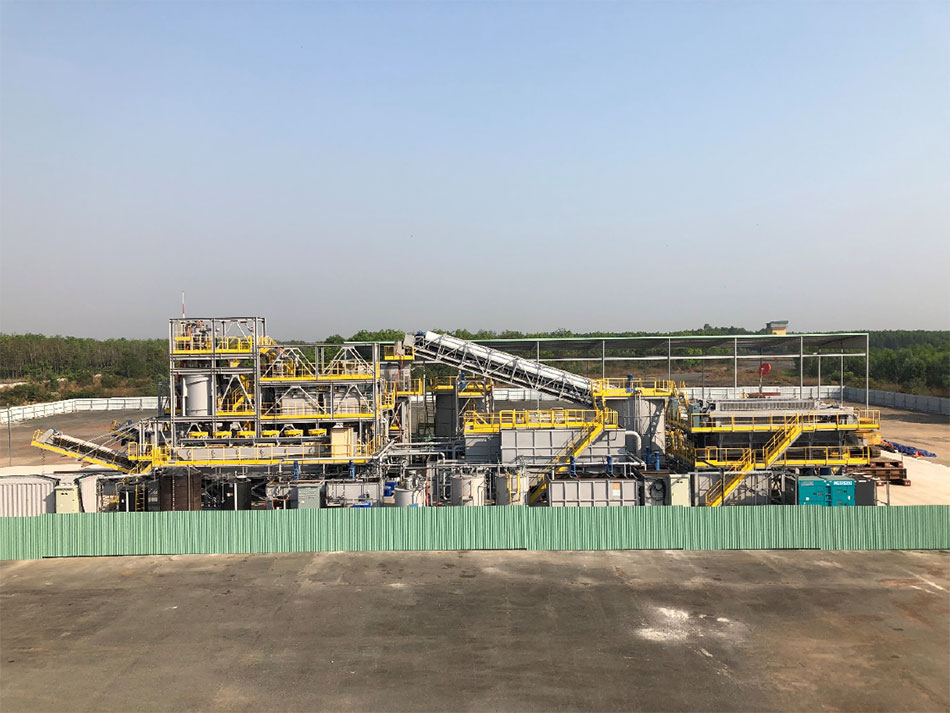December 8, 2020
Shimizu Corporation(President: Kazuyuki Inoue)obtained approval from the Vietnamese Ministry of National Defence and performed two joint demonstration experiments with the Center for Technology of Environmental Treatment(CTET)in 2019 and 2020 at Bien Hoa airbase in Dong Nai Province to verify the effectiveness of washing technology for contaminated soil with dioxins from defoliants. Today, officials from the Vietnamese and U.S. governments were invited to a hotel in the city of Hanoi to announce the results.
Shimizu developed the contaminated soil washing technology and use its practical applications and has a achievement several million tons in Japan. Shimizu aims to participate in the dioxin-contaminated soil washing project in planned at Bien Hoa airbase. We built a soil washing plant for actual use at the airbase that conduct to verify the effectiveness of our technology to highly contaminated soil for the project. It washed 900 tons of contaminated soil in the demonstration experiment. The plant is capable of processing 30,000 to 37,500 m3/year when operated eight hours a day, and 65,000 to 80,000 m3/year when operating 16 hours a day.
Shimizu’s soil washing technology uses the affinity of contaminants for adhering to fine particles of soil. After water is added to the soil, it is sorted according to particle size and the contaminants are removed along with the fine particles without being discharged in the water. Fine particles comprise 30% to 35% of the soil at Bien Hoa Airport, so 65% to 70% of the soil can be reused. The hazardous substances removed along with the fine particles are rendered harmless by separate thermal treatment. For example, we reduced a dioxin concentration from 3500 ppt to 100 ppt or less from the contaminated soil(Removal rate is 95% or higher)on the demonstration experiments. Dioxin concentration standards in Vietnam are 300 ppt for residential land in urban areas and 600 ppt in recreational land.
CTET and other related institutions in Vietnam oversaw and evaluated the demonstration experimental process. They concluded that Shimizu’s soil washing technology was excellent in terms of the reliability of the technology, the volume processed per time unit, the environmental impact, energy conservation, and cost. In terms of the environment impact, for example, they found that the process does not disperse dioxins into the wastewater or air, there is no residual contamination after the plant is removed, workers are not exposed to dioxins, and the process uses far less energy than heat treatment. On the cost front, the combination of Shimizu’s washing technology and heat treatment under the condition of reducing post-processing dioxin concentration in the soil to 100 ppt or less results in an average total cost that is roughly 85% of what it costs for heat treatment alone. Trial calculations indicated that it possible to reduce the cost of roughly 65% of the cost of heat treatment alone at a concentration level of 600 ppt or less.
Shimizu aims to participate in the dioxin decontamination project on the Bien Hoa airbase grounds, a truly humanitarian activity that the Vietnamese and U.S. governments are pursuing in Vietnam, using our soil washing technology, which was proven to have excellent characteristics.
≪For Reference≫

The information contained in this news release is the current information on the date of publication. Please be aware that this information may have changed by the time you view it. Please contact the company to inquire for further details.
